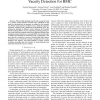Free Online Productivity Tools
i2Speak
i2Symbol
i2OCR
iTex2Img
iWeb2Print
iWeb2Shot
i2Type
iPdf2Split
iPdf2Merge
i2Bopomofo
i2Arabic
i2Style
i2Image
i2PDF
iLatex2Rtf
Sci2ools
FMCAD
2007
Springer
2007
Springer
Exploiting Resolution Proofs to Speed Up LTL Vacuity Detection for BMC
—When model-checking reports that a property holds on a model, vacuity detection increases user confidence in this result by checking that the property is satisfied in the intended way. While vacuity detection is effective, it is a relatively expensive technique requiring many additional model-checking runs. We address the problem of efficient vacuity detection for Bounded Model Checking (BMC) of LTL properties, presenting three partial vacuity detection methods based on the efficient analysis of the resolution proof produced by a successful BMC run. In particular, we define a characteristic of resolution proofs – peripherality – and prove that if a variable is a source of vacuity, then there exists a resolution proof in which this variable is peripheral. Our vacuity detection tool, VaqTree, uses these methods to detect vacuous variables, decreasing the total number of model-checking runs required to detect all sources of vacuity.
| Added | 07 Jun 2010 |
| Updated | 07 Jun 2010 |
| Type | Conference |
| Year | 2007 |
| Where | FMCAD |
| Authors | Jocelyn Simmonds, Jessica Davies, Arie Gurfinkel, Marsha Chechik |
Comments (0)

